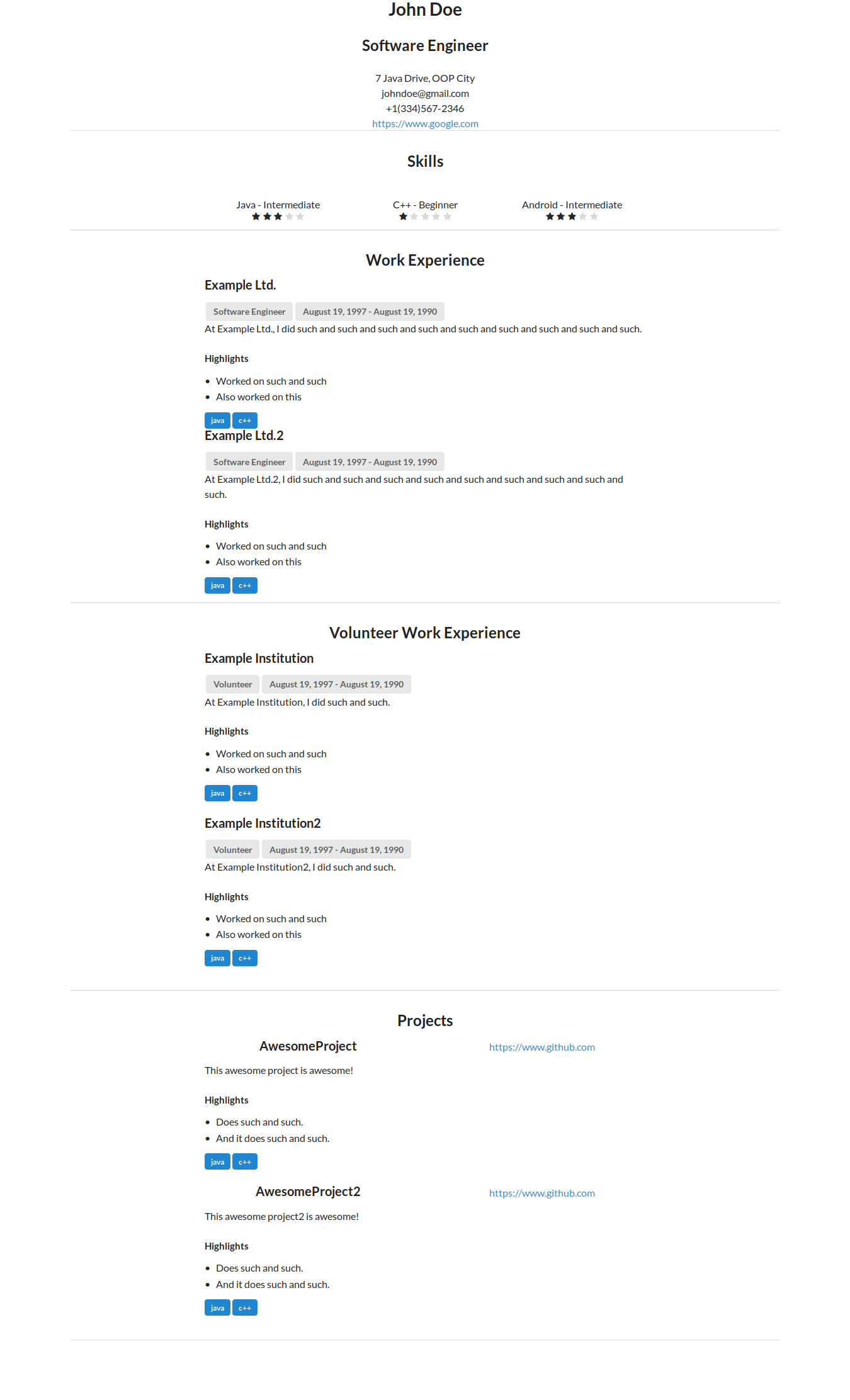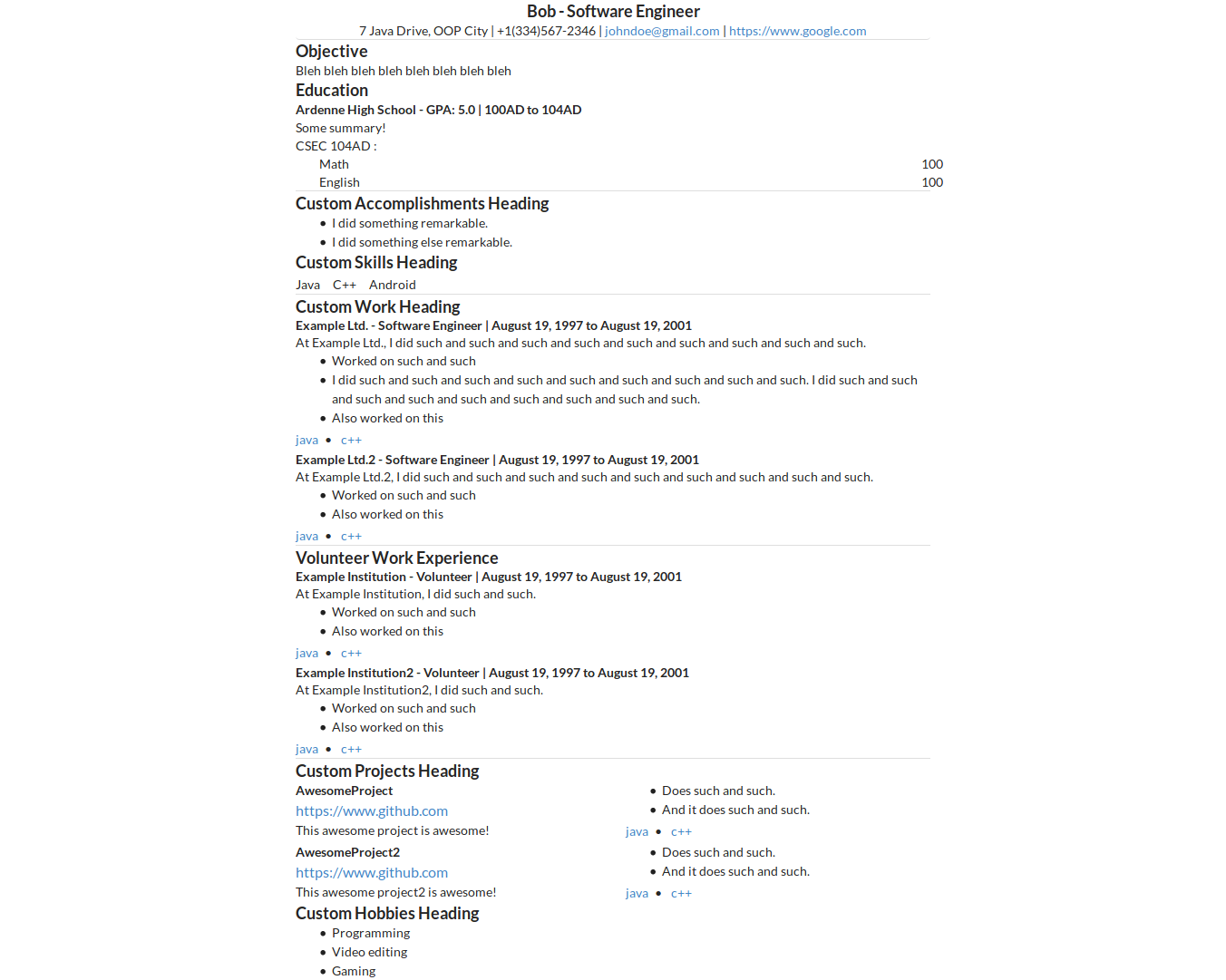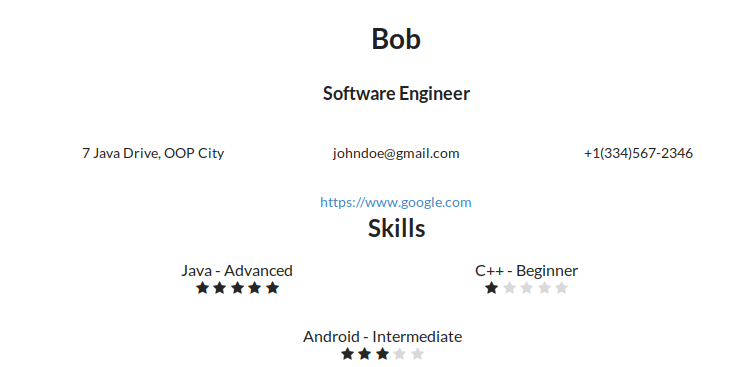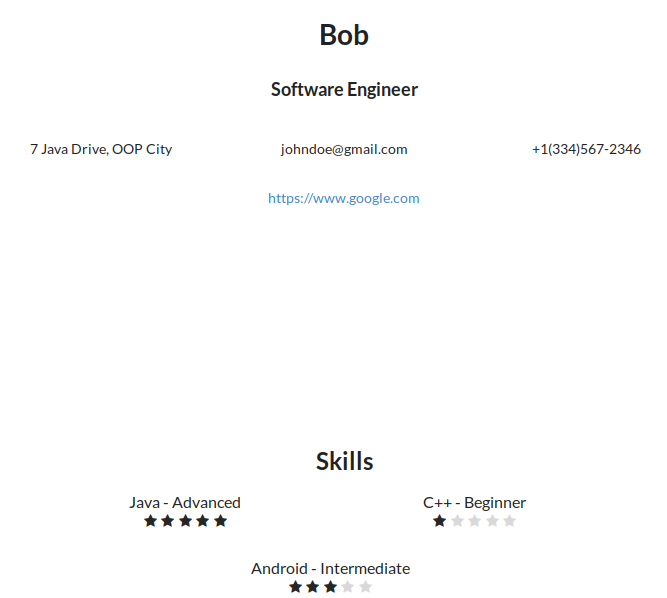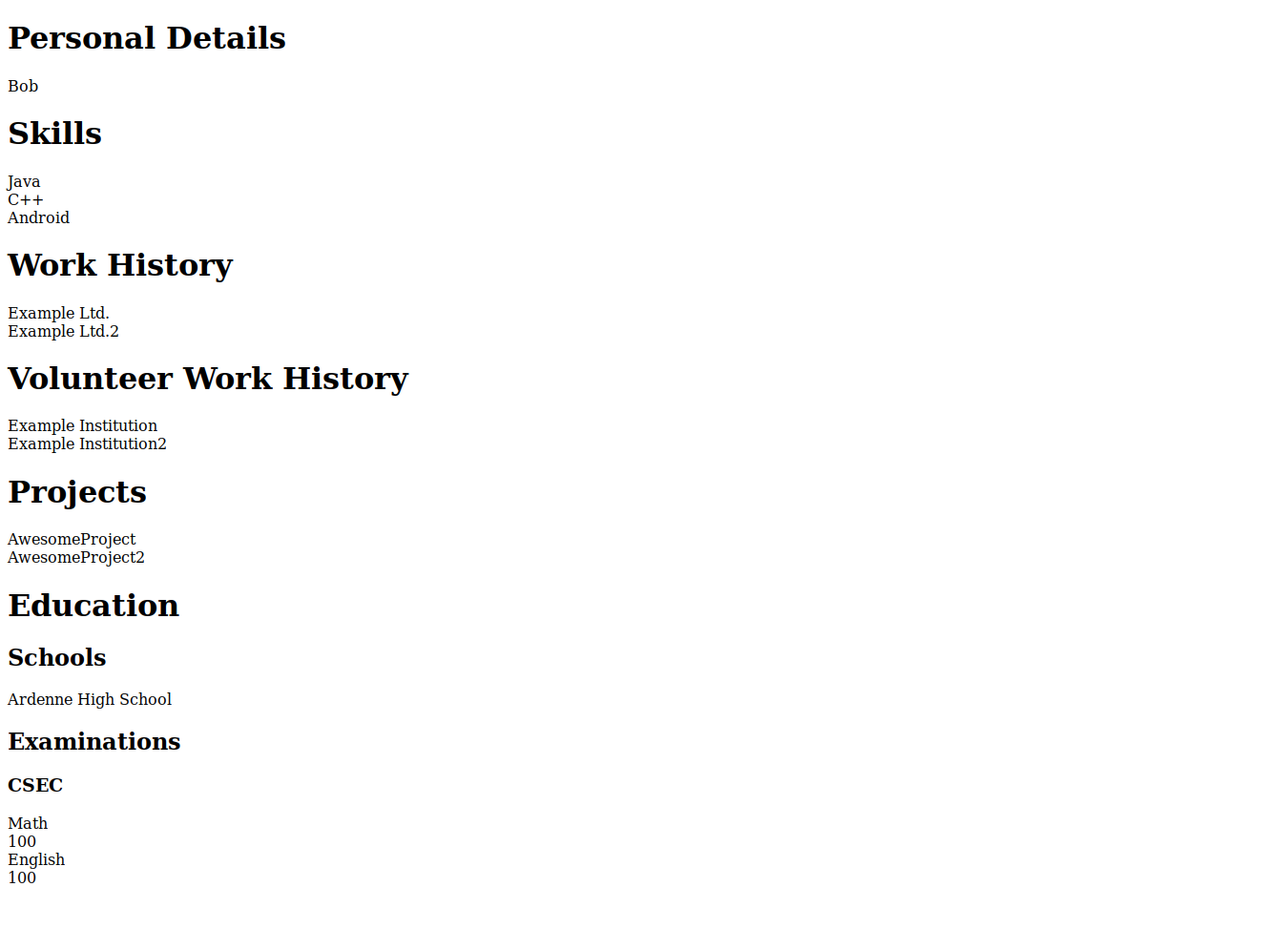#JResume - The best JSON to HTML resume generator.
##Example usage
###Example JSON resume (example.json):
{
"person": {
"name": "Bob",
"email": "johndoe@gmail.com",
"address": "7 Java Drive, OOP City",
"phoneNumber": "+1(334)567-2346",
"jobTitle": "Software Engineer",
"website": "https://www.google.com"
},
"skills": [
{
"name": "Java",
"competence": "Advanced"
},
{
"name": "C++",
"competence": "Beginner"
},
{
"name": "Android",
"competence": "Intermediate"
}
],
"jobWork": [
{
"company": "Example Ltd.",
"position": "Software Engineer",
"summary": "At Example Ltd., I did such and such and such and such and such and such and such and such and such.",
"startDate": "August 19, 1997",
"endDate": "August 19, 2001",
"highlights": [
"Worked on such and such",
"Also worked on this"
],
"keywords": [
"java",
"c++"
]
},
{
"company": "Example Ltd.2",
"position": "Software Engineer",
"summary": "At Example Ltd.2, I did such and such and such and such and such and such and such and such and such.",
"startDate": "August 19, 1997",
"endDate": "August 19, 2001",
"highlights": [
"Worked on such and such",
"Also worked on this"
],
"keywords": [
"java",
"c++"
]
}
],
"volunteerWork": [
{
"company": "Example Institution",
"position": "Volunteer",
"summary": "At Example Institution, I did such and such.",
"startDate": "August 19, 1997",
"endDate": "August 19, 2001",
"highlights": [
"Worked on such and such",
"Also worked on this"
],
"keywords": [
"java",
"c++"
]
},
{
"company": "Example Institution2",
"position": "Volunteer",
"summary": "At Example Institution2, I did such and such.",
"startDate": "August 19, 1997",
"endDate": "August 19, 2001",
"highlights": [
"Worked on such and such",
"Also worked on this"
],
"keywords": [
"java",
"c++"
]
}
],
"projects": [
{
"name": "AwesomeProject",
"description": "This awesome project is awesome!",
"highlights": [
"Does such and such.",
"And it does such and such."
],
"keywords": [
"java",
"c++"
],
"url": "https://www.github.com"
},
{
"name": "AwesomeProject2",
"description": "This awesome project2 is awesome!",
"highlights": [
"Does such and such.",
"And it does such and such."
],
"keywords": [
"java",
"c++"
],
"url": "https://www.github.com"
}
],
"projects": [
{
"name": "AwesomeProject",
"description": "This awesome project is awesome!",
"highlights": [
"Does such and such.",
"And it does such and such."
],
"keywords": [
"java",
"c++"
],
"url": "https://www.github.com"
},
{
"name": "AwesomeProject2",
"description": "This awesome project2 is awesome!",
"highlights": [
"Does such and such.",
"And it does such and such."
],
"keywords": [
"java",
"c++"
],
"url": "https://www.github.com"
}
],
"education": {
"schools": [
{
"name": "Ardenne High School",
"startDate": "2009",
"endDate": "2014",
"summary": "Some summary!",
"gpa": "5.0",
"examinations": [
{
"name": "CSEC",
"startDate": "2014",
"subjects": [
{
"name": "Math",
"result": "100"
},
{
"name": "English",
"result": "100"
}
]
}
]
}
],
"examinations": [
{
"name": "CSEC",
"startDate": "2014",
"subjects": [
{
"name": "Math",
"result": "100"
},
{
"name": "English",
"result": "100"
}
]
}
]
},
"numSkillColumns": 3,
"numPersonalDetailsColumns": 3
}
###Usage:
java -jar jresume.jar --input example.json --output output --theme default
###Output:
###Customizing space between sections
You may use numPrecedingLineBreaks or numFollowingLineBreaks to add space before or after each section respectively.
####Spacing examples:
Without Spacing:
"person": {
"name": "Bob",
"email": "johndoe@gmail.com",
"address": "7 Java Drive, OOP City",
"phoneNumber": "+1(334)567-2346",
"jobTitle": "Software Engineer",
"website": "https://www.google.com"
},
...
With Spacing:
"person": {
"name": "Bob",
"email": "johndoe@gmail.com",
"address": "7 Java Drive, OOP City",
"phoneNumber": "+1(334)567-2346",
"jobTitle": "Software Engineer",
"website": "https://www.google.com",
"numFollowingLineBreaks": 10
},
...
###Converting to PDF
If you don't want to use your browser to save the web resume as a pdf, you can install phantomjs and do the following:
phantomjs pdf.js <webresume_file>.html <pdf_resume_file>.pdf
pdf.js is in the root directory of the jresume directory.
##Creating a new Theme.
- Add a new class to the
com.lukechenshui.jresume.themespackage that extendsBaseTheme - Implemented the various functions such as
generateJobWork. The functions such asgenerateJobWork,generateSkills, etc are each responsible for generating the HTML for their respective section of the web resume. - Register your theme in the application by
- Adding
BaseTheme.registerTheme("<commandline_theme_name>", <ThemeClassName>.class);to theregisterThemesfunction inMain.java.
- Adding
- Use your new theme by running:
java -jar jresume.jar --input <input_json_file> --output <output_folder> --theme <commandline_theme_name>
See the following code for BasicExampleTheme below: (it can also be found in com.lukechenshui.jresume.themes.BasicExampleTheme
/**
* Created by luke on 1/9/17.
*/
public class BasicExampleTheme extends BaseTheme {
public BasicExampleTheme(String themeName) {
super(themeName);
}
@Override
protected ContainerTag generatePerson() {
//Creates a div with an id of person.
ContainerTag personDiv = div().withId("person");
personDiv.with(h1("Personal Details"));
ArrayList<Tag> children = new ArrayList<>();
Person person = resumeBeingOperatedOn.getPerson();
//The following pattern can be used for all of a Person's attributes, e.g. person.getJobTitle()
if (person.getName() != null) {
ContainerTag nameDiv = div().withText(person.getName());
personDiv.with(nameDiv);
}
children.add(personDiv);
return personDiv;
}
@Override
protected ContainerTag generateJobWork() {
ArrayList<Tag> children = new ArrayList<>();
ContainerTag jobWork = div().withId("jobWork");
jobWork.with(h1("Work History"));
if (resumeBeingOperatedOn.getJobWork() != null) {
for (JobWork work : resumeBeingOperatedOn.getJobWork()) {
//The following pattern can be used for all of a JobWork's attributes, e.g. work.getPosition()
if (work.getCompany() != null) {
children.add(div().withText(work.getCompany()));
}
}
}
jobWork.with(children);
return jobWork;
}
@Override
protected ContainerTag generateVolunteerWork() {
//Can use the same thing as getJobWork();
ArrayList<Tag> children = new ArrayList<>();
ContainerTag volunteerWork = div().withId("volunteerWork");
volunteerWork.with(h1("Volunteer Work History"));
if (resumeBeingOperatedOn.getVolunteerWork() != null) {
for (VolunteerWork work : resumeBeingOperatedOn.getVolunteerWork()) {
//The following pattern can be used for all of a JobWork's attributes, e.g. work.getPosition()
if (work.getCompany() != null) {
children.add(div().withText(work.getCompany()));
}
}
}
volunteerWork.with(children);
return volunteerWork;
}
@Override
protected ContainerTag generateSkills() {
ArrayList<Tag> children = new ArrayList<>();
ContainerTag skills = div().withId("skills");
skills.with(h1("Skills"));
if (resumeBeingOperatedOn.getJobWork() != null) {
for (Skill skill : resumeBeingOperatedOn.getSkills()) {
//The following pattern can be used for all of a Skill's attributes, e.g. skill.getCompetence()
if (skill.getName() != null) {
children.add(div().withText(skill.getName()));
}
}
}
skills.with(children);
return skills;
}
@Override
protected ContainerTag generateProjects() {
ArrayList<Tag> children = new ArrayList<>();
ContainerTag projects = div().withId("projects");
projects.with(h1("Projects"));
if (resumeBeingOperatedOn.getProjects() != null) {
for (Project project : resumeBeingOperatedOn.getProjects()) {
//The following pattern can be used for all of a Skill's attributes, e.g. project.getUrl()
if (project.getName() != null) {
children.add(div().withText(project.getName()));
}
}
}
projects.with(children);
return projects;
}
@Override
protected ContainerTag generateEducation() {
ArrayList<Tag> children = new ArrayList<>();
ContainerTag education = div().withId("education");
education.with(h1("Education"));
if (resumeBeingOperatedOn.getEducation() != null) {
Education educationObj = resumeBeingOperatedOn.getEducation();
if (educationObj.getSchools() != null) {
children.add(h2("Schools"));
for (School school : educationObj.getSchools()) {
//The following pattern can be used for all of a Skill's attributes, e.g. school.getGpa()
if (school.getName() != null) {
children.add(div().withText(school.getName()));
}
}
}
if (educationObj.getExaminations() != null) {
children.add(h2("Examinations"));
for (Examination examination : educationObj.getExaminations()) {
//The following pattern can be used for all of a Skill's attributes, e.g. examination.getGpa()
if (examination.getName() != null) {
children.add(h3(examination.getName()));
if (examination.getSubjects() != null) {
for (ExaminationSubject subject : examination.getSubjects()) {
if (subject.getName() != null) {
children.add(div().withText(subject.getName()));
}
if (subject.getResult() != null) {
children.add(div().withText(subject.getResult()));
}
}
}
}
}
}
}
education.with(children);
return education;
}
}
Registering BasicExampleTheme in Main.java's registerThemes function:
BaseTheme.registerTheme("basicexampletheme", BasicExampleTheme.class);
Which outputs the following when provided with example.json:
####Adding CSS and JavaScript to your new Theme
To load custom scripts and stylesheets from CSS frameworks like Semantic UI, you need add the stylesheets to resources/resources.zip and modify generateHead. See the following code snippet from the generateHead in com.lukechenshui.jresume.themes.DefaultTheme:
protected void generateHead() {
ArrayList<Tag> children = new ArrayList<>();
Person person = resumeBeingOperatedOn.getPerson();
ContainerTag head = head();
EmptyTag firstSemanticUI = link().withRel("stylesheet").withHref(getResource("semantic/dist/semantic.min.css"));
ContainerTag secondSemanticUI = script().withSrc(getResource("semantic/dist/semantic.min.js"));
EmptyTag ratingSemanticCSSComponent = link().withRel("stylesheet").withHref(getResource("semantic/dist/components/rating.min.css"));
ContainerTag jquery = script().withSrc(getResource("jquery-3.1.1.min.js"));
ContainerTag ratingSemanticJSComponent = script().withSrc(getResource("semantic/dist/components/rating.min.js"));
ContainerTag initializeRating = script().withType("text/javascript").withText("$(document).ready(function(){$('.rating').rating('disable');});");
ContainerTag regularSizeTextCSS = style().withText(".regularText{font-size:14px;}");
children.add(jquery);
children.add(firstSemanticUI);
children.add(secondSemanticUI);
children.add(ratingSemanticJSComponent);
children.add(ratingSemanticCSSComponent);
children.add(initializeRating);
children.add(regularSizeTextCSS);
if (person != null && person.getName() != null) {
children.add(title(person.getName()));
}
head.with(children);
head.with(meta().withCharset("UTF-8"));
html = html.with(head);
}
The above loads Semantic UI and some other stuff to the head of the generated html resume. Semantic UI and Bootstrap are already in resources.zip.
You can then apply said styles by calling the withClass function on any of your ContainerTags and passing any of the required css class names:
ContainerTag foo = div().withClass("ui");
